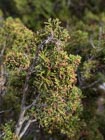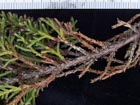
Mature plant in alpine heath, Mt. Field, Tasmania [C.J. Earle, 2015.02.27].

Bark on a mature plant, Mt. Field, Tasmania [C.J. Earle, 2015.02.27].

Diselma and Athrotaxis selaginoides growing together by Crater Lake, Cradle Mountain National Park, Tasmania [C.J. Earle, 2015.03.02].

Twigs and foliage bearing abundant seed cones on a shrub by Wilks Lake, Cradle Mountain National Park, Tasmania [C.J. Earle, 2015.03.03].

Diselma and mats of Microcachrys tetragona (only a few cm tall) growing above timberline on Cradle Mountain, Tasmania [C.J. Earle, 2015.03.03].

Diselma growing above timberline on Cradle Mountain, Tasmania. The plants are strongly windformed and appear to be migrating downwind after the fashion of Picea engelmannii on Niwot Ridge, Colorado [C.J. Earle, 2015.03.03].

Detail of twigs and foliage bearing immature seed cones; Cradle Mountain National Park, Tasmania [C.J. Earle, 2015.03.03].

Distribution map (Brown et al. 1983). The side of each square measures 10 km. A blue square indicates arboretum collections; a green square denotes a written record. You can also create a highly detailed map, and access specimen data, using the "search" function at the Australia Virtual Herbarium.

Conservation Status

Diselma archeri
Hooker f. 1860
Common names
Cheshunt pine (Farjon 2010).
Taxonomic notes
The sole species in Diselma Hooker 1857. Syn: Fitzroya archeri Bentham et Hooker (Vidakovic 1991). Lectotype R.C. Gunn s.n., "summit of the western mountains and falls of Meander," 1849.03.09, K.
Description
An evergreen dioecious shrub or small tree, 1-6 m tall and up to 40 cm diameter, single- or multi-trunked, often forming extensive bushes rooted from a common base. Bark scaly, rough, brown weathering to gray, with a reddish-brown inner bark. Branches short, rigid, numerous, very densely branched. Twigs 4-sided or even 3-sided, ca. 1.5 mm diameter, covered with closely-appressed, overlapping scale-like leaves, 1-2 × 0.6-1.5 mm, with an obtuse apex. Stomata in two short whitish bands on the lower part of the leaf. Young leaves at first reddish, soon turning green or olive-green. Pollen cones terminal, numerous, solitary, to 3 mm long. Seed cones terminal, 3 × 2 mm, comprised of 2 pairs of opposite cone scales around a central columella, maturing in one season. Only the upper pair of scales are fertile; the name Diselma is from the Greek for "two, upper berth", a reference to this feature. One or 2 flattened ovoid seeds develop on each fertile scale, each bearing 2-3 marginal wings. Chromosomes n = 11 (Dallimore et al. 1967, Vidakovic 1991, Farjon 2010). See García Esteban et al. (2004) for a detailed characterization of the wood anatomy.
This species can be confused with Microcachrys tetragona and Pherosphaera hookeriana, two other Tasmanian podocarps that commonly co-occur with it and that are also shrubs with very small scale-like leaves. The following table helps to distinguish these species.
| Character |
Diselma |
Microcachrys |
Pherosphaera |
| Habit |
1-6 m tall |
Up to 30 cm tall |
To 2.5 m tall |
| Twigs |
3- or 4-sided |
Long, slender, whip-like |
Forming stiff tufts of foliage |
| Pollen cones |
Numerous, to 3 mm long |
Recurved, 2.5-4 mm long |
Numerous, globose, 2 mm diam. |
| Seed cones |
2 pairs of opposite scales |
Ovoid, 6-8 mm long, bright red |
Globose, 3-4 mm diam., with 5-8 spreading concave scales |
Distribution and Ecology
Tasmania: the western coast and interior, at elevations of 550-1400 m, primarily on acidic soils in subalpine and alpine moorland and boulderfields. The climate is very damp and snow is possible in any season, sometimes persisting through the winter (Farjon 2010). The species has no fire resistance and grows in areas where fire is very rare or unknown. Hardy to Zone 8 (cold hardiness limit between -12.1°C and -6.7°C) (Bannister and Neuner 2001).
It commonly occurs with Athrotaxis cupressoides, A. selaginoides, Microcachrys tetragona, Pherosphaera hookeriana, and Podocarpus lawrencii, as will as with sundry angiosperm genera of the alpine heath, such as Astelia alpina, Richea scoparia, and Eucalyptus coccifera (pers. obs., Tasmania, 2015).
Remarkable Specimens
It is reported to grow as a tree, at sizes up to over 10 m tall and 60 cm dbh, at Mount Read near Roseberry (Corbett [no date]).
Ethnobotany
Observations
I found it common at alpine heath sites in Mt. Field National Park and in Cradle Mountain National Park.
Remarks
The genus name means "two decks" in reference to the structure of the seed cone. The epithet remembers William Archer (1820-1874), Tasmanian businessman and amateur botanist. The common name, Cheshunt pine, commemorates Archer's estate "Cheshunt" in Tasmania.
Citations
Brown, M.J., J.B. Kirkpatrick and A. Moscal. 1983. An atlas of Tasmania's endemic flora. Tasmania Conservation Trust, 102, Bathurst Street, Hobart 7000, Tasmania. 110pp. ISBN 0959981683.
Corbett, Keith. [no date]. The Mount Read Huon Pine. http://www.apstas.com/Mt__Read_Huon_pine.html, accessed 2010.03.29, now defunct.
Hooker, J. D. 1860. The botany of the Antarctic voyage of H.M. discovery ships Erebus and Terror in the Years 1839-1843 under the command of Captain Sir James Clark Ross (Flora Tasmaniae), V. 3, pt. 1, p. 353. Available: Biodiversity Heritage Library, accessed 2022.12.20.
See also
Baker, R.T. and H.G. Smith. 1910. A Research on the Pines of Australia. N.S.W. Technical Education Series No. 16. Sydney.
Farjon (2005) provides a detailed account, with illustrations.
Hughes, Stephen. 1981. Diselma archeri. http://www.anbg.gov.au/gnp/gnp11/diselma-archeri.html, accessed 2006.03.08. Includes photos and horticultural advice.








